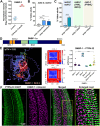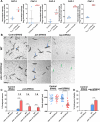A conserved protein tyrosine phosphatase, PTPN-22, functions in diverse developmental processes in C. elegans
- PMID: 39173071
- PMCID: PMC11373843
- DOI: 10.1371/journal.pgen.1011219
A conserved protein tyrosine phosphatase, PTPN-22, functions in diverse developmental processes in C. elegans
Abstract
Protein tyrosine phosphatases non-receptor type (PTPNs) have been studied extensively in the context of the adaptive immune system; however, their roles beyond immunoregulation are less well explored. Here we identify novel functions for the conserved C. elegans phosphatase PTPN-22, establishing its role in nematode molting, cell adhesion, and cytoskeletal regulation. Through a non-biased genetic screen, we found that loss of PTPN-22 phosphatase activity suppressed molting defects caused by loss-of-function mutations in the conserved NIMA-related kinases NEKL-2 (human NEK8/NEK9) and NEKL-3 (human NEK6/NEK7), which act at the interface of membrane trafficking and actin regulation. To better understand the functions of PTPN-22, we carried out proximity labeling studies to identify candidate interactors of PTPN-22 during development. Through this approach we identified the CDC42 guanine-nucleotide exchange factor DNBP-1 (human DNMBP) as an in vivo partner of PTPN-22. Consistent with this interaction, loss of DNBP-1 also suppressed nekl-associated molting defects. Genetic analysis, co-localization studies, and proximity labeling revealed roles for PTPN-22 in several epidermal adhesion complexes, including C. elegans hemidesmosomes, suggesting that PTPN-22 plays a broad role in maintaining the structural integrity of tissues. Localization and proximity labeling also implicated PTPN-22 in functions connected to nucleocytoplasmic transport and mRNA regulation, particularly within the germline, as nearly one-third of proteins identified by PTPN-22 proximity labeling are known P granule components. Collectively, these studies highlight the utility of combined genetic and proteomic approaches for identifying novel gene functions.
Copyright: © 2024 Binti et al. This is an open access article distributed under the terms of the Creative Commons Attribution License, which permits unrestricted use, distribution, and reproduction in any medium, provided the original author and source are credited.
Conflict of interest statement
The authors have declared that no competing interests exist.
Figures





Update of
-
A conserved protein tyrosine phosphatase, PTPN-22, functions in diverse developmental processes in C. elegans.bioRxiv [Preprint]. 2024 Mar 15:2024.03.12.584557. doi: 10.1101/2024.03.12.584557. bioRxiv. 2024. Update in: PLoS Genet. 2024 Aug 22;20(8):e1011219. doi: 10.1371/journal.pgen.1011219. PMID: 38559252 Free PMC article. Updated. Preprint.
Similar articles
-
A conserved protein tyrosine phosphatase, PTPN-22, functions in diverse developmental processes in C. elegans.bioRxiv [Preprint]. 2024 Mar 15:2024.03.12.584557. doi: 10.1101/2024.03.12.584557. bioRxiv. 2024. Update in: PLoS Genet. 2024 Aug 22;20(8):e1011219. doi: 10.1371/journal.pgen.1011219. PMID: 38559252 Free PMC article. Updated. Preprint.
-
Actin organization and endocytic trafficking are controlled by a network linking NIMA-related kinases to the CDC-42-SID-3/ACK1 pathway.PLoS Genet. 2018 Apr 2;14(4):e1007313. doi: 10.1371/journal.pgen.1007313. eCollection 2018 Apr. PLoS Genet. 2018. PMID: 29608564 Free PMC article.
-
A life cycle alteration can correct molting defects in Caenorhabditis elegans.Dev Biol. 2022 Mar;483:143-156. doi: 10.1016/j.ydbio.2022.01.001. Epub 2022 Jan 15. Dev Biol. 2022. PMID: 35038442 Free PMC article.
-
Conserved Ankyrin Repeat Proteins and Their NIMA Kinase Partners Regulate Extracellular Matrix Remodeling and Intracellular Trafficking in Caenorhabditis elegans.Genetics. 2017 Jan;205(1):273-293. doi: 10.1534/genetics.116.194464. Epub 2016 Oct 31. Genetics. 2017. PMID: 27799278 Free PMC article.
-
The spectraplakins of Caenorhabditis elegans: Cytoskeletal crosslinkers and beyond.Semin Cell Dev Biol. 2017 Sep;69:58-68. doi: 10.1016/j.semcdb.2017.06.003. Epub 2017 Jun 12. Semin Cell Dev Biol. 2017. PMID: 28619622 Review.
Cited by
-
TAT-1, a phosphatidylserine flippase, affects molting and regulates membrane trafficking in the epidermis of Caenorhabditis elegans.Genetics. 2025 Mar 17;229(3):iyae216. doi: 10.1093/genetics/iyae216. Genetics. 2025. PMID: 39722491
-
PIKI-1, a class II phosphatidylinositol 3-kinase, functions in endocytic trafficking.bioRxiv [Preprint]. 2025 May 23:2025.05.22.655458. doi: 10.1101/2025.05.22.655458. bioRxiv. 2025. PMID: 40475523 Free PMC article. Preprint.
-
The dual role of PTPN22 in immune modulation and transplantation tolerance.Hum Cell. 2025 Jan 7;38(2):42. doi: 10.1007/s13577-024-01170-y. Hum Cell. 2025. PMID: 39775468 No abstract available.
-
Phosphorylation-dependent regional motility of the ciliary kinesin OSM-3.J Cell Biol. 2025 Jul 7;224(7):e202407152. doi: 10.1083/jcb.202407152. Epub 2025 Apr 24. J Cell Biol. 2025. PMID: 40272473
References
-
- Shu L, Du C, Zuo Y. Abnormal phosphorylation of protein tyrosine in neurodegenerative diseases. Journal of Neuropathology and Experimental Neurology: Oxford University Press; 2023. p. 826–35. - PubMed
MeSH terms
Substances
Grants and funding
LinkOut - more resources
Full Text Sources
Miscellaneous

